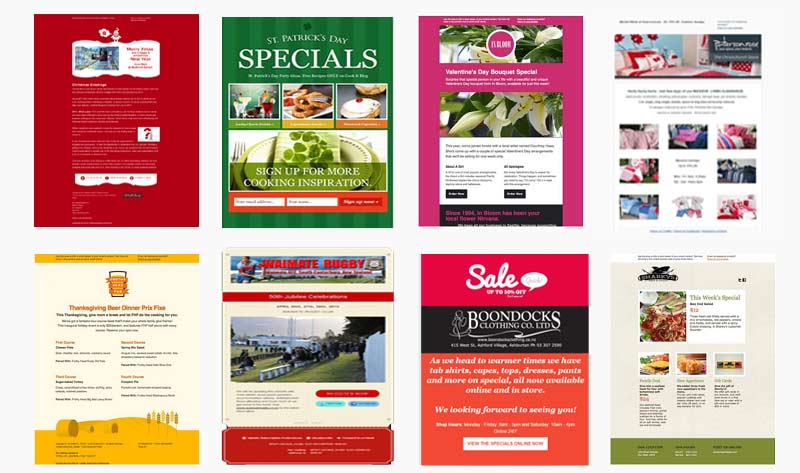Email marketing is a great, inexpensive way to reach the people on your database lists. If done correctly, this type of marketing will take your business to the next level and bring a great ROI for years to come.
Our Experience
Medlicott Design has worked on numerous email marketing campaigns across a variety of themes, with differing reasons for clients.
In some cases it has made pure economical sense – why send out 1000 catalogues that need to be printed, packaged and posted when 90% of those customers are just as happy to receive notification via email as well as the option to buy with the click of a button!
For others it may be about building a community of support or business or organisation “family” members.
Some businesses may use email marketing to tie in with existing loyalty programmes, but in each case using a professional email marketing campaign has many more ticks in the ‘pros’ column than in the “cons” one!
A few important facts that many people should know about
- Most ISPs (e.g. Xtra, Clear, Vodafone) only allow you to send/receive a maximum of about 130 emails per hour – so if you have 400 on your list, 250+ may never receive it! This has become tighter over time as they try to stem the spamming.
- Less than 60% of emailed newsletters are opened across all industries
- Using the right systems you can measure who has or hasn’t opened your emails
- You can see the sections they clicked on i.e. what worked and what didn’t, what was popular or not
- You can use this information to target ‘receptive’ clients
- Can you measure all this by snail mail, or do you just guess when your website gets a few extra hits?
Medlicott Design recommends Mailchimp
In the early days I used to create ‘pretty’ html emails, but these could still not record even a small percentage of the information that the modern email systems can. Aligned with the server issues like the restriction on number of emails sent an hour, building a large list which is generally the aim was actually making it harder not easier, or more time consuming as databases had to be split into manageable groups of 80 – 100 people, as well as returning to the job every 75 minutes to send the next batch of newsletters making it quite time consuming.
There are now a number of solutions, and the one I am most comfortable recommending and using for clients is Mailchimp.
Mailchimp has all the things you can expect from a professional email management system, but why I recommend it for my clients is that it is ideal for small businesses, clubs or organisations in places like New Zealand because if you have less than 2000 subscribers on your list it is FREE!
- MailChimp is completely free for lists with up to 2,000 subscribers.
- You can deliver up to 12,000 emails a month for free – so your 2000 subscribers can get 6 emails a month – more than enough
Once your list goes beyond this number of subscribers you will have to pay, but by then you should know how well your newsletters are going, what works or doesn’t work, and should be able to afford the minimal “marketing campaign costs”.
Mailchimp has 100s of professional newsletter templates to choose from, integrates with Facebook, Twitter, Mobile phones and is easy to add or remove your customer lists to. And if you don’t like the generic Mailchimp designs, there are numerous more free or paid templates available online, or make your own.
For some people it may be a bit of a learning curve to begin with, and often this is where I come in, firstly developing a newsletter template, helping the client understand what different things do or don’t do, helping them understand the viewing stats and reports. The meaning of words like clicks, opens, hard and soft bounces will be soon become second nature and you will be tailoring newsletters to meet both your customers and your own needs.
Here are a couple of important things you can do to improve your email marketing.
Email marketing is a good way to communicate with your list, but it isn’t always the best way to educate, entertain or sell.
- Don’t try to say it all in the email … use all of your resources together. Email is just a great way to get the word out. Different prospects respond to different forms of communication, so don’t be afraid to try different strategies. You don’t have to include everything in the email. Build anticipation by offering a brief explanation and then sending them to a landing page, blog post, product page or other destination that can give them more information.
- Why not include links to videos, podcasts, entertaining articles, social media campaigns, contests or surveys. These options are often a great way to reinforce your message in a unique way.
- Try to offer people on your newsletter something that they can only get by signing up – why would they bother if they can read all the same information on your website? Incentives like specials for newsletter customers only, discounts on old stock that only subscribers get. Perhaps handy tips from a magazine you subscribe to yourself.
- When you send an email, make sure the content is of value to your prospects. A valuable email could contain a special offer that appeals to the buyer, useful educational content, entertainment or content that gives requested information. If they look forward to your newsletters because of these things they are;
- more likely to open your newsletters
- more likely to remain on your list
- more likely to utilise your products or services
- If your emails contain a lot of SPAM related words (such as free, cheap, %, work-from-home, click-here, discount, coupon, special offer, limited time), chances are slim your prospects are even getting them. SPAM filters are becoming more and more sensitive, and they can remove your email before it even gets to the inbox.
- Make sure that your subject lines are intriguing, but that they don’t over promise. Consumers have been jaded by companies promising the world and not delivering. Avoid sensational subject lines that claim “500% increase in sales” or “I lost 20 kgs in 1 week.”
- Be sure that the “from” field is full of useful information, too. Typically, your company name is a good way to ensure recognition and trust
- Sending out too many emails will make you a nuisance that ends up in the trash bin almost immediately. Waiting too long in between emails might cause your prospects to forget you, and will also land your “unrecognizable” email in the trash bin. Find a happy medium where you can stay in touch with prospects without bombarding them with daily emails. I have a newsletter that comes to me that invaruably has really good information, but then they started coming daily, sometimes a couple of times a day and became overwhelming. The writer suddenly had all these people leaving his list and did a survey – turned out most of us really liked the information he gave out, but he was sending too much for us to digest and people were overwhelmed – the reality is we only read newsletters in our spare time, so if you send too many we don’t have any spare time so they just go in the bin!
- Create a strategy – Sending one-off emails to friends and family works great, but it doesn’t work well for marketing. Each email you send out should fit in a greater scheme, and they should all work toward a common goal. For example, you can create an email series that highlights the “3 secrets to success in cold weather gardening.” Each week, you can send out another email packed with data, stories and links relating to one of the secrets. At the end of the series, you can ask recipients to buy your book, attend your garden show or come in for a special discount on tulip bulbs. The emails work together, building anticipation along the way and culminate with a call to action.
- Consistent Follow-Up: One of the major reasons small businesses fail is because they don’t follow up with leads and prospects. In general, it takes several communications with a prospect before he/she is ready to buy. But most businesses give up after 1 or 2 emails. That won’t get the job done. Stop leaving money on the table and start following up with all of your prospects. If you can stay in front of them, educating and building trust along the way, they’ll come to you when they are ready to buy. One of the best ways to have consistent follow-up is through an email sequence. If you put a new lead campaign, a long-term nurture sequence and a new customer campaign in place, you will see dramatic improvement in your conversion.
How to set up an Email Newsletter System
Would you like to look further into using an email marketing campaign?
Not sure where to go from here?
Contact Medlicott Design now and we can discuss strategies, options and a good place to start.



